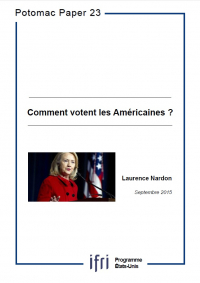Gateway to Think Tanks
| 来源类型 | Publications - Policy Papers - Potomac Papers |
| 规范类型 | 简报 |
| DOI | 978-2-36567-438-6 |
| Comment votent les Américaines ? Potomac Paper, No. 23, September 2015 | |
| Laurence NARDON | |
| 发表日期 | 2015-09-03 |
| 出处 | Potomac Papers |
| 出版年 | 2015 |
| 概述 | Are women going to vote massively for Hillary Clinton in 2016, the same way African-Americans voted for Barack Obama in 2008 and 2012? This paper examines the different aspects of the gender gap in the US, social debates around women's issues and the way the Democratic candidate may... |
| 摘要 |
Comment votent les Américaines ? Potomac Paper, No. 23, September 2015
Are women going to vote massively for Hillary Clinton in 2016, the same way African-Americans voted for Barack Obama in 2008 and 2012? This paper examines the different aspects of the gender gap in the US, social debates around women's issues and the way the Democratic candidate may approach the different segments of the American electorate.  Are women going to vote massively for Hillary Clinton in 2016, the same way African-Americans voted for Barack Obama in 2008 and 2012 ? American women, especially when members of a minority, tend to vote more than men for Democratic candidates. Topics on which this gender gap is particularly strong are the reluctance to send troops overseas and to condone environmentally risky practices, and, to a lesser extent, the support of redistributive policies and of some progressive moral values. However, the identification process of minority voters with a candidate hailing from their ranks is limited : only voters that are Independent or undecided will join the candidate’s electorate in voting for him or her. Voters that consider themselves to be affiliated with the opposite camp will not cross party lines to vote for a candidate from their population group. Hillary Clinton will probably not define her image around her gender in the present campaign, be it by adopting a masculine stance (her mistake in 2008), or by focusing on women’s issues. Indeed, the strength of her candidacy is linked to the way she can represent Americans of all stripes. Nonetheless, Clinton will have to prepare specific talking points to accommodate the different subgroups of the feminine electorate. She will certainly direct part of her narrative towards white women, a segment of the electorate in which she stands to gain numerous voters. Women’s issues are not equally present in the U.S. political debate. Whereas reproductive rights are regularly brandied during electoral campaigns, other issues of public debate such as working conditions, paid maternity leave or childcare mostly stay outside the political arena. Although the academic debate currently tends to focus on Gender Theory, feminism remains active either through online issue-focused activism or through the theory of Intersectionality, held forth by self-described Black feminists.
This content is available in French: Comment votent les Américaines ?
|
| 关键词 | Feminism US 2016 Elections United States |
| URL | https://www.ifri.org/en/publications/enotes/potomac-papers/votent-americaines |
| 来源智库 | French Institute of International Relations (France) |
| 引用统计 | |
| 资源类型 | 智库出版物 |
| 条目标识符 | http://119.78.100.153/handle/2XGU8XDN/416043 |
| 推荐引用方式 GB/T 7714 | Laurence NARDON. Comment votent les Américaines ? Potomac Paper, No. 23, September 2015. 2015. |
| 条目包含的文件 | ||||||
| 文件名称/大小 | 资源类型 | 版本类型 | 开放类型 | 使用许可 | ||
| voteamericaines_couv(31KB) | 智库出版物 | 限制开放 | CC BY-NC-SA |  浏览 | ||
| voteamericaines_pp23(972KB) | 智库出版物 | 限制开放 | CC BY-NC-SA | 浏览 | ||
除非特别说明,本系统中所有内容都受版权保护,并保留所有权利。